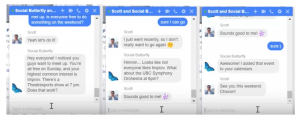#5a – Rationale of Medium Fidelity Prototyping Approach
There are two components to our experiment design; one is the onboarding experience where we gather the users’ preferences about their interests and friends, and the other is the SocialButterfly chatbot. To gather the users’ preferences, we decided that a website was more effective and user-friendly than an app, as after setting the initial preferences, the user would not frequently go back to edit them. Though the onboarding experience is not the primary focus of our experiment, it is an integral part of how the chatbot works, as it provides the necessary information for the chatbot to help plan events more efficiently.
The onboarding experience is mostly implemented horizontally to allow the user to experience creating a complete profile. The Facebook login, the search-and-select-friend functionality, and the ability to link to a calendar, are specifically Wizard of Oz’d,because while they are clickable, their functionality is faked behind the scenes since we are not evaluating those functions. Logging in through Facebook and connecting to one’s calendar are reduced to one-step processes by removing the authorization functionality provided by Facebook or Google (for Google Calendars) to connect to one’s account. As friends are imported from Facebook, we created friend profiles. The selection of ‘best friends’ is still up to the user. The way the user indicates their interests and their social burnout levels are prototyped more thoroughly. We prototyped the burnout levels sliders because it is a secondary experiment goal to evaluate if users are able to understand the burnout concept. The combination of horizontal and vertical implementation of should sufficiently convince the subject that the system is mostly implemented. Axure provided the ease for having mouse events on elements like selecting interests, friends, the calendar the user wanted to link to. The dynamic panels allow us to easily make state changes to single elements without doing much redundant work. It also allows us to prototype a web page easily, which in turn, also provides a more realistic onboarding experience for the users.
The main experiment goals focus on evaluating the usefulness of the chatbot, but it in order to test that, it didn’t make sense to create the chatbot and integrate it into Facebook Messenger without doing a preliminary test of its usefulness. Instead, by naming one of the evaluators SocialButterfly, and participating in a group chat, responding to keywords and command prompts during a conversation, and Wizard-of-Ozing the chatbot, we can evaluate our experiment goals. The evaluator will change his or her profile picture to the SocialButterfly logo and only respond to the given commands using the set answers to emulate the chatbot effectively.
Blog Update #5b – Prototype Demonstrations
We decided to Wizard-of-Oz the chat bot by renaming one of us to SocialButterfly and responding using just the preset responses that we had set up. This allowed us to evaluate our experiment goals without the additional work of re-creating Facebook Messenger which had an integrated chat bot. This method allows us to show our participants how the chat bot would communicate with them and gives the participants a chance to provide some insight on the feasibility and usefulness of the bot.
Below, we wanted to highlight the list of the preset commands and answers that SocialButterfly is limited to for our prototype.
Prompt the Butterfly to Suggest a time and event
- “Meet up”
- “Hang out”
- “Do something”
- “Are you free”
- “Catch up”
- “I miss you”
Prompt the Butterfly to Suggest an Alternate Time
- “I can’t do <day of week>”
- “I’m not free”
Prompt the Butterfly to Suggest an Alternate Event
- “I don’t want to do …”
- “I’m not interested”
Prompt the Butterfly that You’re Attending an Event
- “Sure”
- “I can go”
- “Yes”
- “Going”
- “I’m down”
Response: Time and Event Individual
“Hey there! I noticed you guys want to meet up. You’re both free on <day of week>, and you both like <interest>. What about <this event>? Does that work?”
Response: Time and Event Group
“Hey everyone! I noticed you guys want to meet up. You’re all free on <day of week>, and your highest common interest is <interest>. What about <this event>? Does that work?”
Response: Time
“Hmmm… Looks like <proposed day of week> doesn’t work. What about <alternate day of week>?”
Response: Event
“Hmmm… Looks like not everyone likes <proposed event>. What about <alternate event with next common interest>?”
Response: Added to Cal
“Awesome! I added that event to your calendar(s).”Video Demo
The video below summarizes the major design decisions taken when creating the medium-fidelity prototype and addresses the reasons behind them according to technological limitations and human abilities.

